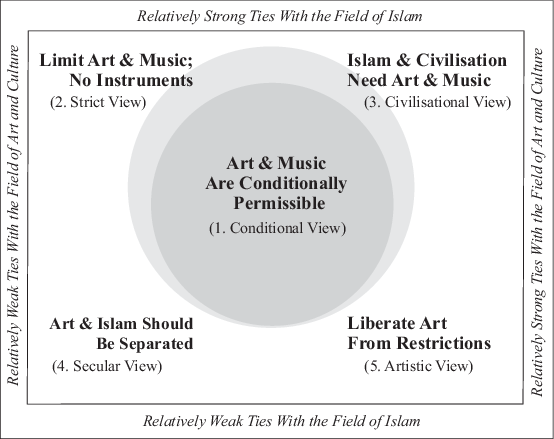The Use of Graphics in Sociological Analysis
Categories in Cultural Orientations
Visualization of Meaning Based on data analysis and argumentations, graphics are able to represent insights on the meta level. Through the visualization of cultural patterns in the distribution of views, they may generate a more immediate understanding of sociological phenomena than written words could do. Subsequently, by means of the qualities of graphics by showing e.g. similarity and distinction, core and periphery, graphics contribute to a fruitful dialectical relationship by providing possible future insights to lines of reasoning about processes and transformations.
Ideological Standpoints For instance, in Islam, culture and authoritative voices in the UK and the US, I have represented the different ideological standpoints in a graphic, called Pattern of Cultural Views to Art and Islam. Based on analysis of interviews with Muslim performing artists in the UK and the US, secondary sources regarding their ideas and productions and participant observation of numerous Muslim cultural events, the religio-artistic views of British and North American Muslim performing artists can be distinguished by five partly overlapping ideological standpoints related to habitus and cultural tastes. These views range between the strict view, the civilizational view, the secular view and the artistic view, and these are more or less centred by the conditional view. They differentiate from each other by their varying relationships with the field of religion and the field of art. The artists can have relatively weak or relatively strong ties to these crucial fields, based on the level on which they take notice of relevant religious advice and aim to connect with the institutions of cultural heritage and those representing contemporary art.
Conditional View In the conditional view, art takes care of guidelines acquired from religion. Resembling the moderate kind of stance to art and music in other major religions, it legitimates cultural productions with content that is considered appropriate, i.e. deriving from decent intentions of the maker and performed in proper circumstances. This conditional view advocates social and elevating cultural intentions of a non-sexual nature that endeavors to be beneficial to human beings generally.
Strict View In the strict view, art anticipates on restrictions deduced from religion. In the present field of art, the strict view partly, yet evidently, relates to the conditional view but advocates clearly defined boundaries that ‘limit art and music’. Aware of the conditions for appropriate and decent content, in their quest for the most legitimate practices that align the fundamentals of Islam these male Muslim performing artists try to stay away from the use of controversial instruments.
Civilisational View In the civilisational view, culture and art are integral to religion. Compared to the views of authoritative voices in the art and Islam debate in the Muslim world, the civilizational view is a new perspective. Muslim performing artists with this view are convinced that Islam needs art and music because it is cultures that take Islam forward in terms of the level of civilisation. The view that “civilization and Islam need art and music” is based on interdependence: Islam cannot sustain without human beings, and human beings can only blossom through the development of their cultures.
Secular View In the secular view, art and religion belong to different domains of life. Upholding the view that “art and Islam should be separated,” Muslim performing artists approve of musical instruments and women on stage without hesitations and perceive the art and Islam debate as ridiculous, or as something that is opposite to their personal conception of Islam. These artists tend to regard religious faith as part of their private lives that needs no spiritual expression on public stage.
Artistic View Lastly, in the artistic view, art and religion are combined in an unconditional and reciprocal way. Muslim performing artists with the artistic view are particularly eager to “liberate art from restrictions.” They argue that the creation of art is intrinsically impossible when conditional and under restrictions, no matter what kind. At the same time, they practise and explain art in a way that is, to different degrees, informed by their way of Islamic faith, which seems especially shaped by regularly reflecting on Islamic conditions considered to be imposed on art and other issues.
Benefits Building on the visualisation of the distribution of cultural views in graphics, it is quite easy to understand the dynamics between views and the fluidity between social positions. These kinds of understandings contribute to the elaborations of further argumentations.
Van Tilborgh, Y. “Islam, culture and authoritative voices in the UK and the US: Patterns of orientation and autonomy among Muslims in art”, Zeitschrift für Religion, Gesellschaft und Politik 2/1 (2018) 101–34.
Free download: link.springer.com/article/10.1007/s41682-018-0017-y

